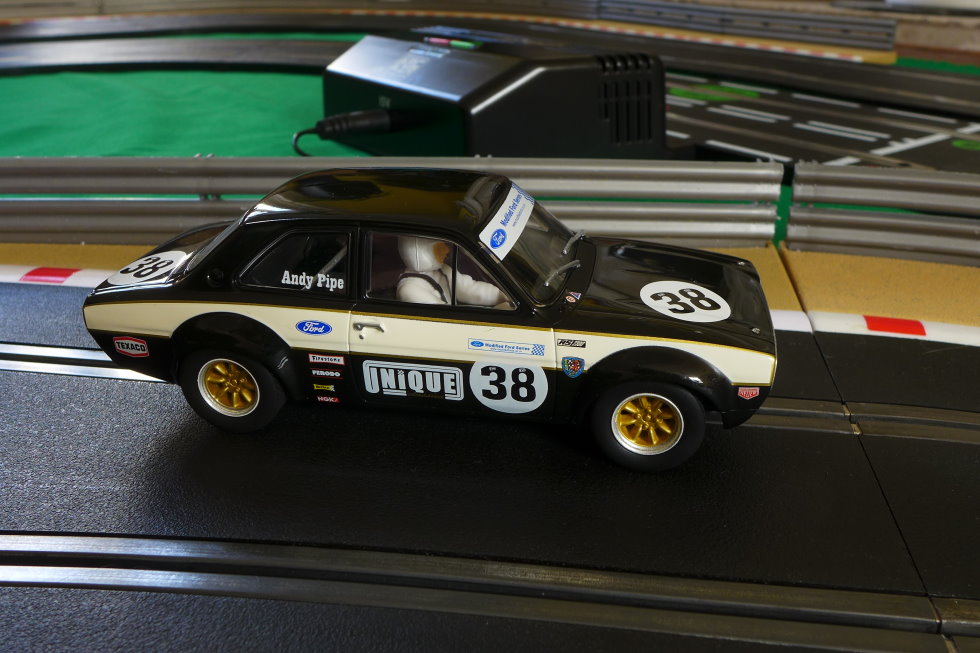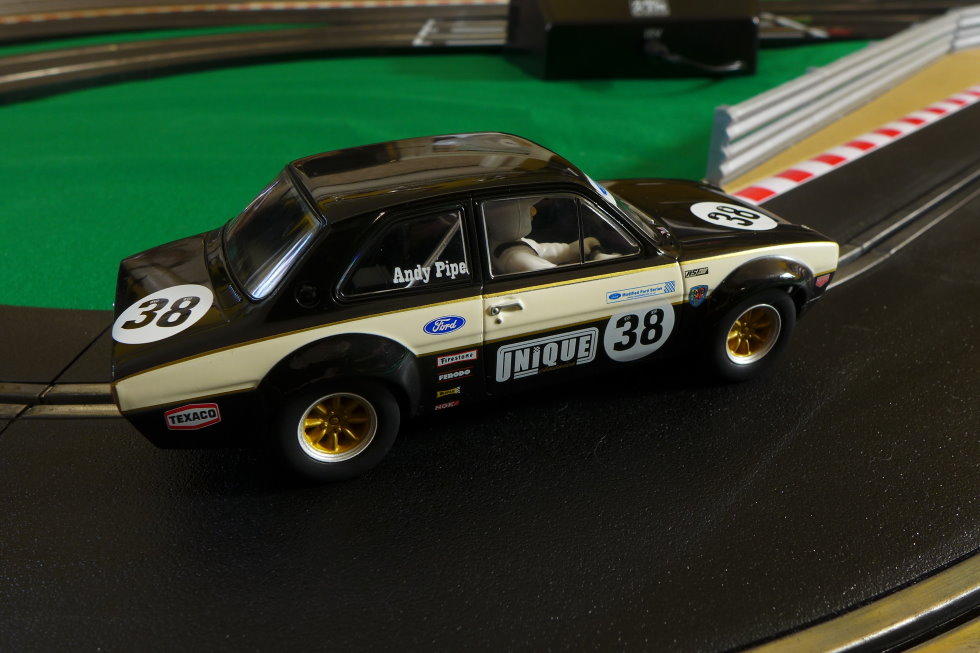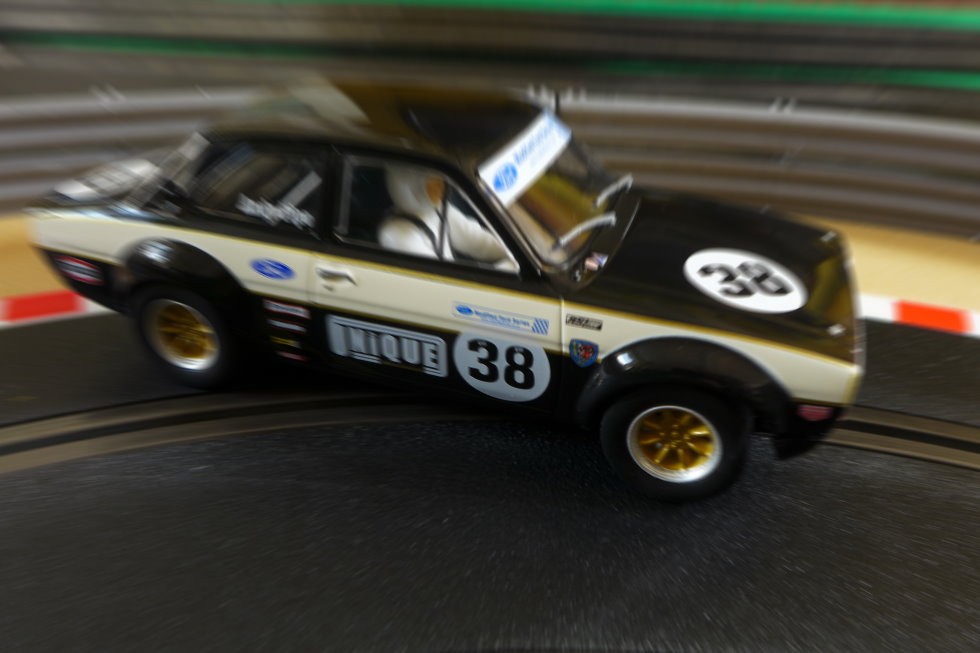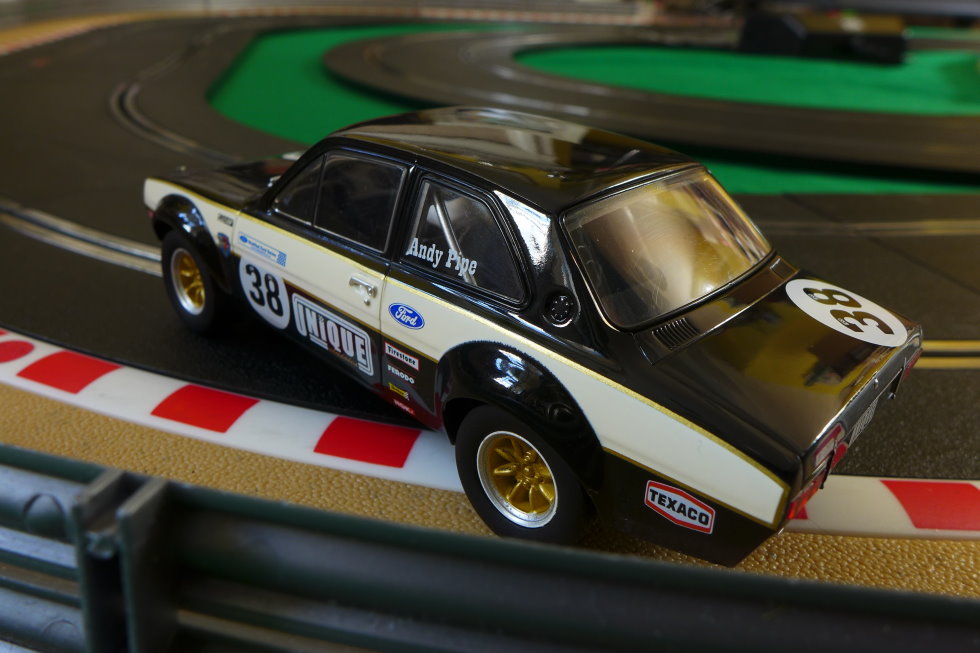Scalextric have pulled another great Escort out of the bag…
We heard from Andy Pipe in last week’s blog post, so we know a lot about the car this model is based on. And it is an absolute stunner. Scalextric know they are onto a winner with their classic Fords – many of us either drove or admired these cars when we were younger. This Escort model is also a tribute to Andy and all the other grass-roots racers who prepare cars that look and sound sensational – and they continue to thrill on tracks and rally stages around the world every weekend.
But what’s the model like? It’s time for an in-depth review and track test. Plus a look at a non-magnet set-up for the Escort.
Don’t forget you can buy the Andy Pipe Racing Escort Mk1 here: https://www.jadlamracingmodels.com/scalextric-slot-car-c4237-ford-escort-mk1-andy-pipe-racing/ and there’s a digital version here: https://www.jadlamracingmodels.com/scalextric-digital-slot-car-c4237-ford-escort-mk1-andy-pipe-racing/
The Real Ford Escort
To me, the Escort is the British saloon car. A best-selling family car, a top circuit racer and a legendary rally car – well over four million Escorts were sold in the UK between 1968 and 2004, most of them made at the Halewood plant on Merseyside.
Andy Pipe’s race car started out life as a standard two-door 1100cc model. These made up the bulk of the two million Mk1 Escorts made across Europe in the first six years of production. Of course, Andy has turned the basic shell into a magnificent racing machine – but there were some highly sought-after performance versions available at the time…
Although designed for rallying, Alan Mann’s Twin Cams excited crowds in the British Saloon Car Championship – Frank Gardner winning the 1968 title. The RS1600 replaced the Twin Cam and was developed at the new Advanced Vehicle Operations (AVO) facility in Essex – which spawned the Escort Mexico, the BDA engine and the RS2000. This line of Escorts saw plenty of competitive success and also created a new market for ‘hot’ road cars.
Today, Mark 1 Escorts are extremely desirable. Whether restored as classic road cars, entered in historic rallies or raced on circuits, they fetch hefty prices. That says something about how much the Escort is revered in British car culture.
The Scalextric Model
This Escort mould first appeared in the Scalextric catalogue back in 2006. There have been a couple of dozen road, rally and track versions since then. Of course, there was also a very nice Escort Mexico produced in the 1970s. They all sell well and go for high prices on the collectors’ market.
The Scalextric Mk1 shape – with the bubble arches – is perfect to recreate Andy Pipe’s Modified Ford racer. Front and rear bumpers are removed, although there should be a front spoiler. Andy’s car only has one big windscreen wiper, instead of two smaller ones – plus we don’t get any wing mirrors on the Scalextric model.
However, the overall look of the car is sensational – from the gold Minilite wheels to an incredibly sharp 1:32 scale rendition of the superb black, cream and gold paint job created by Unique Classics. The details on the decoration are perfect and require a magnifying glass to appreciate fully. It is a top-rate Scalextric Escort and definitely one of the best-looking models in the 2021 catalogue.
The Mechanical Stuff
Underneath, there’s the updated Digital Plug Ready (DPR) version of the Escort – making it easy to convert to Scalextric digital using the C8515 digital plug. The tyres are 8mm wide and treaded – which looks a recipe for a decent amount of grip on Scalextric Sport track. On my set-up block, the front tyres are just about sitting on the surface, which means the guide is nice and deep in the slot.
There are six screws to remove – a pair each front and back to hold the body, plus two more midships to anchor the full-depth interior. This is an old-style layout – and the interior screws aren’t necessary and can twist the chassis.
Having removed the screws, the body fits very tightly to the underpan – no chance of any of the nice ‘body float’ that would improve handling. The front valance is part of the underpan and the front light board has traditional LED ‘bulbs’ rather than the more up-to-date surface mount version – although these are on the rear board. The motor is the ‘slim-can’ FF-050, which is used because it’s all that will fit with the deep interior and narrow underpan. The gearing is the standard 9:27 inline ratio.
If designed today, I suspect the Scalextric Escort would have a tray interior and the bigger Mabuchi S-can motor underneath. The FF-050 motor is quite different from the usual S-can. It is more powerful – and much of that power comes in very quickly. That’s one reason why there’s a really strong neodymium magnet fitted underneath the motor – measuring 75g of downforce in the car on my DIY magnet gauge. Most recent cars come in around 45 to 50g. The extra downforce tames the power.
Another reason for that whopping magnet is because the Escort is narrow and top-heavy. The magnet dramatically lowers the centre of gravity to prevent the car from tipping over. However, the extra downforce will also heat up the motor quite quickly – so best to keep to short sprint races. I’ve seen people mention their new Escorts have ‘burnt out’ or stopped after 15 minutes – this is probably why. If you prefer to run without magnets, heat won’t be an issue – but the Escort will be a challenge to tune.
Let’s see how the car performs on our Jadlam SL6 Test Track…
Track Performance
The standard set-up gives a quick and well-planted car, which brakes nicely when I lift off the throttle. That magnet certainly tames the slim-can motor and allows the Escort to carry some good speed through the corners. Push too hard and the car tips onto its roof or side – there is no warning and no rear end slide to control. The only place I managed anything approaching a slide was through a fast left-right section just before the end of the lap.
Cranking up the ARC app for a 2-minute timed run, I managed 24 laps and a best of 4:44 seconds – but the car was twitchy and I rolled it three times. One thing I noticed was the motor was getting very hot after just those two minutes of running.
There are a few things I like to do to a new car to improve handling – loosen the screws, re-profile the pick-up braids and scuff up the rear tyres. You can read more about these tweaks here. First, I loosened the four body screws and completely removed the two that anchor the cockpit. That allowed the body to rattle just a little on the underpan – but was it enough to make the car more stable going into corners? Another 2-minute test run gave me a clean run of 26 laps and a best time of 4:30 seconds. The car felt much better, although the motor was still getting hot.
Next, I re-profiled the braids by unhooking the bottom flap and bending it backwards. This reduces the thickness of the braid and gets the guide deeper in the slot – a big deal for cars that understeer. A 2-minute run gave 26 laps and a best of 4:28 seconds.
Finally, I scuffed up the tyres on my DIY tyre truer. The Escort’s tyres are treaded, so this isn’t such a big deal as with slick tyres – but it will remove the worst of any moulding imperfections. I then gave the tyres a good clean on some masking tape. In another 2-minute run, the Escort completed 27 laps – almost 28 – with a best time of 4:11 seconds. That will put Andy Pipe’s Escort high up on the SL6 leaderboard, so those three simple tweaks are worth doing to get your Escorts handling better and going faster. They won’t sort out the heat issue though.
Mag-less Escort
I love this Escort and I want to have maximum fun with it on the track. I’m sure Andy is delighted his car beats some of the latest Scalextric GT3 cars – but I’m not 100% sure that’s realistic… My preference is for it to be less stuck down and much more ‘loose’ in the corners. That means running with no traction magnet – which should also avoid the motor overheating so quickly.
I started by simply taking out the traction magnet – it comes out easily once the rear axle and motor are removed. That gave a wildly tail-out car with non-stop power slides. Using the ARC App, I reduced the Max Power setting (via Driver Set-up) to 75% and made sure the Throttle Curve was set to ‘Profile A’. That meant the car was more controllable and more fun. A 2-minute run gave just 15 laps and best time of 7:07 seconds. But it was good fun – and the motor was barely warm.
The Escort desperately needed more grip at the back, so started by adding 2.5g of lead weight into the magnet pocket. I used thin ‘Golf Swing Weight Tape’ as my usual lead sheet was too thick to fit under the motor. I used a double thickness of tape and folded over the ends to mimic the magnet’s shape. A 2-minute test run saw the Escort manage a couple of inches less than 17 laps and a fast time of 6:88 seconds – so the mag-less Escort is heading in the right direction…
But why race without magnets if the cars are so much slower? Ultimately, it’s personal preference – I think there’s a time and a place for both. Non-mag racing is slower, but that can be handy for digital formats where you have six cars racing on two lanes. There is more time to think – to plan overtakes, adjust pit strategy, avoid crashing into the other cars – and if there is contact, damage is much reduced. Mag-less cars can also look more realistic – especially for classic racers that didn’t have the massive aerodynamic downforce and wide wheels of modern cars. Those cars were slower and tended to slide around. However, it is possible to get a pretty quick slot car without magnets, but it does take some work.
I’ll use some of the tweaks from my Scalextric Tuning series (here) to continue to develop the mag-less Escort. Using ARC Air or ARC Pro, the software reduces the power of the FF-050 motor. If you don’t use ARC, then fitting a lower-revving motor is essential for non-mag running. Better tyres would also really help, but the wheels don’t take the NSR or Slot.it sizes. More truing and softening will improve the grip of the standard rubber – or I can look around for some specialist urethane tyres for the Scalextric Escort wheels.
One other thing I’m considering is fitting a lightweight vac-formed tray interior. This will lower the centre of gravity significantly and give space for me to add some weight either side of the motor. It does mean losing the full-length driver figure – although the lighter, more nimble car will be exactly what Andy Pipe wants to see battling for wins in a Scalextric Modified Ford race.
Next week, I’ll be looking at the Modified Ford Series – including some formats for ARC Pro and ARC Air which simulate a typical Sunday of racing for this wonderful mix of fast Fords…
Scalextric Ford Escort Mk1 ‘Andy Pipe Racing’ Data Sheet
Catalogue code: C4237
Range: Scalextric Classic Touring Cars – 1/32 scale / high detail / Digital Plug Ready (DPR)
Released: June 2021
Spares included: 2 x braid plates with braid fitted
Lights: front and rear
Motor: Scalextric ‘slim-can’ – inline orientation.
Gear ratio: 9:27
Length: 120mm
Wheelbase: 74mm
Rear axle width: 50mm
Height: 40mm
Weight: 75g (body = 29g)
Andy’s downforce gauge: 75g magnetic downforce



















